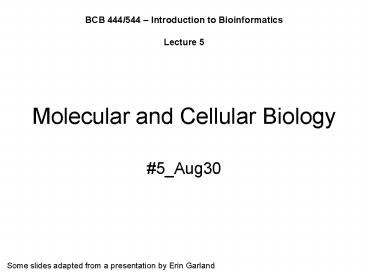Molecular and Cellular Biology - PowerPoint PPT Presentation
1 / 26
Title:
Molecular and Cellular Biology
Description:
Knowledge-based Approaches to Predicting Protein Interface Hot Spots ... Web resources. BioTech's Life Science Dictionary. Online textbooks NCBI bookshelf ... – PowerPoint PPT presentation
Number of Views:300
Avg rating:3.0/5.0
Title: Molecular and Cellular Biology
1
Molecular and Cellular Biology
BCB 444/544 Introduction to BioinformaticsLect
ure 5
- 5_Aug30
Some slides adapted from a presentation by Erin
Garland
2
Announcements
Knowledge-based Approaches to Predicting Protein
Interface Hot Spots Julie Mitchell Department
of Mathematics and Biochemistry BACTER Institute
for Computational Biology University of
Wisconsin, Madison Today at 310 in 1420 MBB
3
Eukaryotic Cell
Lots of compartments Compartments are called
organelles
4
Prokaryotic Cell
No separate compartments
5
Cytoskeleton
6
Extracellular Matrix
7
Cell cycle
8
The Central Dogma
Gene expression the whole process of going from
DNA to RNA to Protein
9
Information flow in the cell
- DNA -gt RNA -gt protein
- Transcription DNA to RNA
- Translation RNA to protein
- Exceptions reverse transcription, RNA splicing
and editing, protein post-translational
modification
10
DNA replication
- Replication is semiconservative
- Each child strand has one of the parent strands
Replication fork
- Replication only occurs in the 5 to 3 direction
11
Transcription
DNA encoding gene messenger RNA
12
Translation
Codon 3 bases that code for an amino acid
messenger RNA protein
Amino acids
tRNA
mRNA
ribosome
13
Genetic code
14
Mutations
- Nonsense stop codon in the wrong place
- Missense mutation that results in an amino acid
change in the protein - Synonymous mutation in the DNA that does not
result in an amino acid change in the protein - Non-synonymous does change the amino acid
15
Protein function
- Proteins are the primary molecules responsible
for cellular function - They have complex structure and some can perform
chemical reactions (enzymes)
DNA structure
Protein structure (dystrophin)
16
Protein localization
17
RNA function
- Some specialized RNA molecules have function
Ribosomes contain both RNA and protein
Ribozymes are RNA-based enzymes capable of RNA
cleavage
- RNA molecules may be the precursors to life as
they can both - Form complementary base pairs and replicate (like
DNA) - Perform enzymatic functions (like proteins)
18
3 classical types of RNA
- mRNA messenger RNA
- tRNA transfer RNA
- rRNA ribosomal RNA
- Lots of others siRNA, miRNA, piRNA, snRNA,
snoRNA,
19
Genes
Genes are not just beads on a string they
have complex structure
20
Gene structure
- Genes are fragmented, containing
non-protein-coding introns between the functional
exons
21
Gene splicing
Introns are removed before mRNA leaves the nucleus
DNA
Transcribed RNA
Introns removed by splicing
mRNA
22
Gene regulation
- Genes are regulated transcriptionally by proteins
that interact with DNA elements around the gene - DNA level
- Promoters
- Enhancers and repressors
- Chromatin level (X-inactivation)
- Genes are also regulated
- Post-transcriptionally
- Post-translationally
23
Promoters
- RNA polymerase binds and transcription begins at
the promoter - Transcription regulation focuses on the promoter
24
Enhancers and repressors
Regions further upstream from the promoter have
binding sites for enhancer and repressor proteins
promoter
enhancer
gene
10-50,000 bp
repressor
25
Transcription factor binding sites
- Promotors, enhancers, and repressors are all
binding sites for transcription factors (proteins
that bind DNA and affect transcription)
26
Web resources
- BioTechs Life Science Dictionary
- Online textbooks NCBI bookshelf































